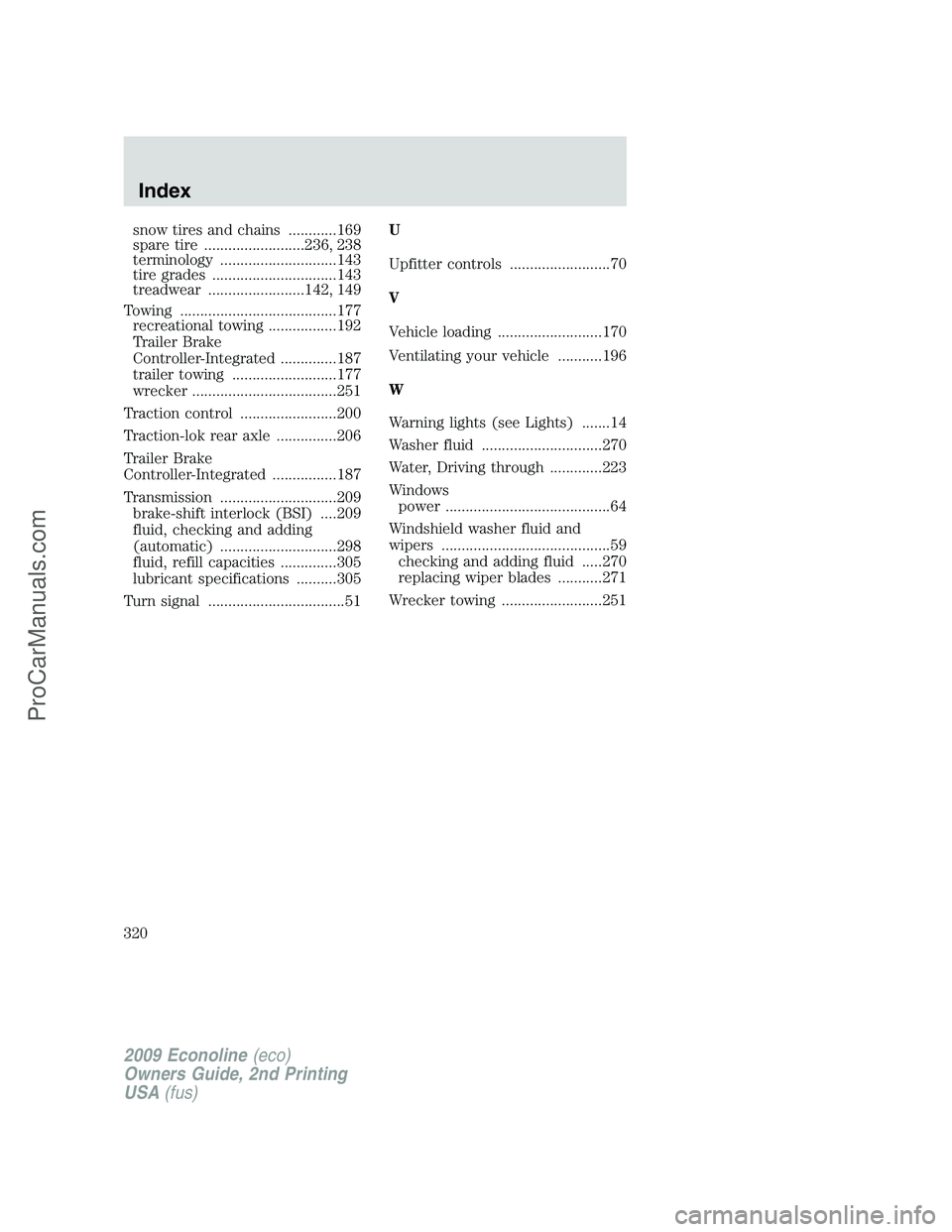Page 195 of 320

•Turn the key to 4 (on) without
turning the key to 5 (start).
Some warning lights will briefly illuminate. SeeWarning lights and
chimesin theInstrument Clusterchapter for more information
regarding the warning lights.
Starting the engine
1. Turn the key to 4 (on) without
turning the key to 5 (start).
2. Turn the key to 5 (start), then
release the key as soon as the
engine starts. Excessive cranking
could damage the starter.
Note:If the engine does not start within five seconds on the first try,
turn the key to 3 (off), wait 10 seconds and try again. If the engine still
fails to start, press the accelerator to the floor and try again; this will
allow the engine to crank with the fuel shut off in case the engine is
flooded with fuel.
Cold weather starting (flexible fuel vehicles only)
The starting characteristics of all grades of E
85ethanol make it
unsuitable for use when ambient temperatures fall below 0°F (-18°C).
Consult your fuel distributor for the availability of winter grade ethanol.
As the outside temperature approaches freezing, ethanol fuel distributors
should supply winter grade ethanol (same as with unleaded gasoline). If
summer grade ethanol is used in cold weather conditions, 0°F to 32°F
(-18°C to 0°C), you may experience increased cranking times, rough idle
or hesitation until the engine has warmed up.
1
2
34
5
3
2
1
5
4
2009 Econoline(eco)
Owners Guide, 2nd Printing
USA(fus)
Driving
195
ProCarManuals.com
Page 290 of 320

If you have run out of fuel:
•You may need to cycle the ignition from off to on several times after
refueling to allow the fuel system to pump the fuel from the tank to
the engine. On restarting, cranking time will take a few seconds longer
than normal.
•Normally, adding 1 gallon (3.8L) of fuel is enough to restart the
engine. If the vehicle is out of fuel and on a steep grade, more than
1 gallon (3.8L) may be required.
•TheService engine soon
indicator may come on. For more
information on theService engine soon
indicator, refer to
Warning lights and chimesin theInstrument Clusterchapter.
ESSENTIALS OF GOOD FUEL ECONOMY
Measuring techniques
Your best source of information about actual fuel economy is you, the
driver. You must gather information as accurately and consistently as
possible. Fuel expense, frequency of fill-ups or fuel gauge readings are
NOT accurate as a measure of fuel economy. We do not recommend taking
fuel economy measurements during the first 1,000 miles (1,600 km) of
driving (engine break-in period). You will get a more accurate
measurement after 2,000 miles–3,000 miles (3,000 km–5,000 km).
Filling the tank
The advertised fuel capacity of the fuel tank on your vehicle is equal to
the rated refill capacity of the fuel tank as listed in theMaintenance
product specifications and capacitiessection of this chapter.
The advertised capacity is the amount of the indicated capacity and the
empty reserve combined. Indicated capacity is the difference in the
amount of fuel in a full tank and a tank when the fuel gauge indicates
empty. Empty reserve is the small amount of fuel remaining in the fuel
tank after the fuel gauge indicates empty.
The amount of usable fuel in the empty reserve varies and should
not be relied upon to increase driving range. When refueling your
vehicle after the fuel gauge indicates empty, you might not be
able to refuel the full amount of the advertised capacity of the
fuel tank due to the empty reserve still present in the tank.
For consistent results when filling the fuel tank:
•Turn the engine/ignition switch to the off position prior to refueling,
an error in the reading will result if the engine is left running.
2009 Econoline(eco)
Owners Guide, 2nd Printing
USA(fus)
Maintenance and Specifications
290
ProCarManuals.com
Page 318 of 320

K
Keyless entry system
autolock .....................................80
Keys .............................................90
positions of the ignition .........193
L
Lamps
bulb replacement
specifications chart ..................53
daytime running light ...............47
headlamps .................................47
headlamps, flash to pass ..........48
instrument panel, dimming .....48
interior lamps ...........................51
replacing bulbs .........................54
LATCH anchors .........................128
Lights, warning and indicator ....14
anti-lock brakes (ABS) ..........199
Load limits .................................170
Loading instructions .................176
Locks
autolock .....................................80
doors ..........................................80
Lubricant specifications ...........305
Lug nuts ....................................244
Lumbar support, seats ...............94
M
Message center ...........................71
warning messages .....................76
Mirrors ...................................65–66
automatic dimming rearview
mirror ........................................65
fold away ...................................67
side view mirrors (power) .......66Motorcraft parts ................267, 304
N
Navigation system .......................43
O
Octane rating ............................288
Oil (see Engine oil) ..................271
P
Parking brake ............................199
Parts (see Motorcraft parts) ....304
Power distribution box
(see Fuses) ...............................231
Power door locks ........................80
Power mirrors .............................66
Power point .................................63
Power steering ..........................206
fluid, checking and adding ....296
fluid, refill capacity ................305
fluid, specifications .................305
Power Windows ...........................64
Preparing to drive your
vehicle ........................................207
R
Radio ................................22, 24, 29
Recommendations for
attaching safety restraints for
children ......................................122
Relays ........................................228
Remote entry system .................84
illuminated entry ......................88
2009 Econoline(eco)
Owners Guide, 2nd Printing
USA(fus)
Index
318
ProCarManuals.com
Page 320 of 320

snow tires and chains ............169
spare tire .........................236, 238
terminology .............................143
tire grades ...............................143
treadwear ........................142, 149
Towing .......................................177
recreational towing .................192
Trailer Brake
Controller-Integrated ..............187
trailer towing ..........................177
wrecker ....................................251
Traction control ........................200
Traction-lok rear axle ...............206
Trailer Brake
Controller-Integrated ................187
Transmission .............................209
brake-shift interlock (BSI) ....209
fluid, checking and adding
(automatic) .............................298
fluid, refill capacities ..............305
lubricant specifications ..........305
Turn signal ..................................51U
Upfitter controls .........................70
V
Vehicle loading ..........................170
Ventilating your vehicle ...........196
W
Warning lights (see Lights) .......14
Washer fluid ..............................270
Water, Driving through .............223
Windows
power .........................................64
Windshield washer fluid and
wipers ..........................................59
checking and adding fluid .....270
replacing wiper blades ...........271
Wrecker towing .........................251
2009 Econoline(eco)
Owners Guide, 2nd Printing
USA(fus)
Index
320
ProCarManuals.com